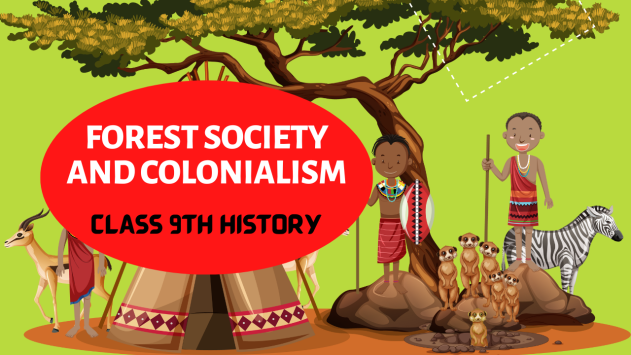We are providing Forest Society And Colonialism Class 9th NCERT notes to help the students with the chapter Forest Society And Colonialism Class 9th so that students are able to understand the scientific forestry, various reasons for exploitation of the natural resources of the Indian Forests, and comparison has also been drawn between forest laws of Java and India.
We have also provided some important maps regarding Forest Society And Colonialism Class 9th to help the students with the chapter along with NCERT Solutions For Class 9th Forest Society And Colonialism.
Forest Society And Colonialism Class 9th: Introduction
DEFORESTATION
The disappearance of the forests is referred to as deforestation. Under colonial rule, it became very systematic and extensive.
Reasons for deforestation
Land to be improved-
As the population increased over the centuries and the demand for food went up, peasants extended the boundaries of cultivation by clearing forests. The British encouraged the production of commercial crops like jute, sugar, wheat, and cotton for their industries as raw materials. The British thought that forests were unproductive land as they yielded no revenue nor agricultural produce. Cultivation was viewed as a sign of progress.
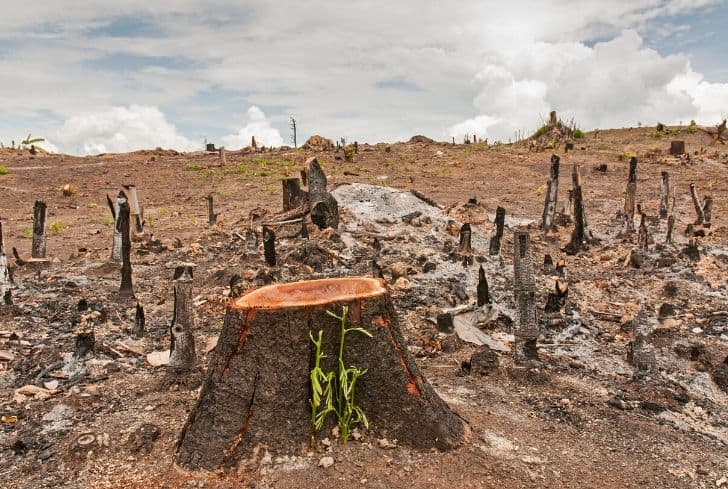
Oak forests in England were disappearing. There was no timber supply for the shipbuilding industry. Forest resources of India were used to make ships for the Royal
Navy. Leapers on the track
Spread of railways required two things :
land to be cleared to lay railway tracks
wood as fuel for locomotives and for railway line sleepers.
Plantations
Large areas of natural forests were cleared for tea, coffee, and rubber plantations.
Thus the land was given to planters at cheap rates.
Forest Society And Colonialism Class 9th: Commercial Forestry
The British were worried that the use of forests by local people and the reckless felling of
trees by traders would destroy forests and hence invited German expert Dietrich Brandis as the first Inspector General of Forests in India.
Brandis set up the Indian Forest Service in 1864 and helped formulate the Indian Forest Act of 1865. The Imperial Forest Research Institute was set up in Dehradun in 1906.
Scientific forestry was taught there.
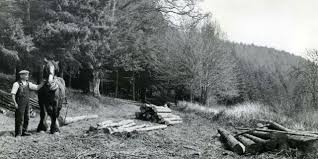
In the scientific forestry system, forests with different kinds of trees were replaced by plantations. Forest management plans were made by forest officials. They planned how much of the forest had to be cut and how much had to be replanted.
The Forest Acts divided forests into
Reserved forests- These were the best forests villagers could not enter these
forests.
Protected forests, Village forests– Villagers could take wood for fuel and house building from here.
Forest Society And Colonialism Class 9th: Forest Rules and Cultivation
Shifting cultivation or swidden agriculture was the agricultural practice in many parts of Asia, Africa, and South America. The colonial foresters did not favor this system as it made it difficult for the government to calculate taxes.
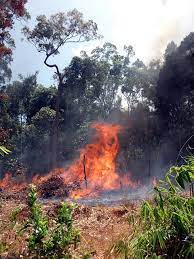
In addition, the forest officials saw in it the danger of fire and also that no trees could grow on this kind of land. The lives of the forest people and nearby villagers depended upon the forests. Their various needs of fuel, fodder, and even food were dependent on forests. As these people were not allowed to use the forest, their life became difficult.
Hunting and Forest Laws
The forest laws stopped the villagers from hunting in the forests but encouraged hunting as a big sport. They felt that the wild animals were savage, wild, and primitive, just like the Indian society and that it was their duty to civilize them.
New Trade and New Employment-
New opportunities opened in the trade as the forest department took control of the forests, e.g., the Mundurucu peoples of the Brazilian Amazon. With the colonial influence, trade was completely regulated by the government. Many large European trading firms were given the sole right to trade in forest products of a particulate area. Many pastoral communities lost their means of livelihood. New opportunities for work did not always mean improved well-being for the people.
Forest Society And Colonialism Class 9th: Forest Rebellion
Forest communities rebelled against the changes imposed upon them. The people of Bastar were one such group. The people here believed that the land was given to them by the earth and in return, they look after the earth. Their cultural and social life was connected to the forest.
The initiative was taken by the Dhurwas of the Kanger forest where reservation first took place. The British sent troops to suppress the rebellion. It took them three months to regain control. A victory for the people of Bastar was that the work on the reservation was suspended and the area was reduced to half.
CHANGES IN JAVA
Java is now famous as a rice-producing island in Indonesia. But once upon a time, it was
covered with forests. Dutch were the colonizers of Java.
The Kalanga-
Kalanga were skilled forest cutters and shifting cultivators. They rose in rebellion against the Dutch in 1770 but their uprising was suppressed.
Scientific Forestry in Java: Forest laws were enacted in Java. The villagers resisted these
laws. Forest timber was used for ships and railway sleepers. The Dutch government used the ‘balandongdiensten’ system for extracting free labor from the villagers.
Samin’s Movement: Samin of Randublatung village (a teak forest village) questioned the
state ownership of forests. A widespread movement spread. They protested by lying on the ground when the Dutch came to survey it and refusing to pay taxes and perform labor.
World Wars and Deforestation: The world wars had a major impact on forests. The forest department cut freely to meet the British demands. The Dutch followed the scorched earth policy of destroying sawmills, and burning logs of teak so that the Japanese could not benefit from it. The Japanese forced the villagers to cut down forests when they occupied the area.
New Developments: Conservation and preservation of forests have now become the focus rather than timber. It has also been realized that if forests are to survive, the local
community needs to be involved. There are many such examples in India where
communities are conserving forests in sacred groves. This looking after is done by each
member of the village and everyone is involved.
NCERT Solutions For Class 9th Forest Society And Colonialism
Question 1: Discuss how the changes in forest management in the colonial period affected the following groups of people:
(a) Shifting cultivators
New forest laws banned shifting cultivation. For shifting cultivators, it was devastating
because there was a problem with their survival. Many of them were forced to migrate to take up some other occupations. Many others were forced to work in the tea plantations.
(b) Nomadic and pastoralist communities
The grazing of animals was banned under the new forest laws. It made the life of
pastoralist communities difficult. Herds animals were their only source of livelihood. The nomadic communities were declared criminal communities. This made their life miserable because they could no longer move freely.
(c) Firms trading in timber/forest produce
Because of the huge demand for timber, it was a boon for timber merchants. They must
have seen good growth in their incomes.
(d) Plantation owners
The land was given at cheaper rates to the plantation owners. Labour was also made
available to them at very low wages. Moreover, new policies were made which prevented the workers from going back to their home villages. It was a win-win situation for the plantation owner.
(e) Kings/British officials engaged in shikar
The killing of ferocious animals; like tigers or wolves was monetarily rewarded. Moreover,
hunting was viewed as a sign of bravery and valor. The Kings and British officials must have enjoyed the newfound honor in society.
Question 2: What are the similarities between colonial management of the forests in Bastar and in Java?
There were certain similarities in the colonial management of forests in Bastar and
Java. In both cases, the traditional rights of forest dwellers were taken away and they were
forced to work for their colonial masters. Large-scale deforestation took place and felled trees were replaced with monocultural plantations.
Question 3: Between 1880 and 1920, forest cover in the Indian subcontinent declined by 9.7 million hectares, from 108.6 million hectares to 98.9 million hectares. Discuss the role of the following factors in this decline:
(a) Railways
There was a huge demand for sleepers from the railways. In those days
sleepers were made from wood. Expansion of the railway network resulted in large-scale deforestation.
(b) Shipbuilding
Shipbuilding was an important industry because ships were an integral part of
the military power of the British. When the number of oak trees sharply reduced in
Britain, Indian forests provided a good source of supply. Thus, shipbuilding also
contributed to large-scale deforestation in India.
(c) Agricultural expansion
The growing European population meant an increased demand for food
grains. This resulted in the expansion of cultivated land in India. More land was cleared of
forests to make way for cultivation.
(d) Commercial farming
There was increased demand for various raw materials; like cotton and indigo for the expanding industries in Britain. This resulted in large-scale commercial farming in
India. This could also become possible by clearing forests
(e) Tea/coffee plantations
Demand for tea and coffee also increased in Britain. The climate of north- Eastern India and the eastern coast were perfect for plantations. Large areas of forests were cleared for making way for plantations. The British plantation owners were given
land on very cheap rates.
(f) Adivasis and other peasant users
Adivasis had always been the protectors of forests and hence they had no
role in deforestation. However, some peasants may have utilized the opportunity to
expand the cultivated land; as had happened in Java. Moreover, the significant
increase in cultivated land also indicates the clearing of forests for farming.
Question 4: Why are forests affected by wars?
The two World Wars had major impacts on forests. More trees were cut to meet the
wartime needs of Britain. In Java, the Dutch followed the ‘scorched earth policy just before the Japanese occupation of the region. They destroyed sawmills and burnt huge piles of giant teak logs. The Japanese continued the exploitation of forests. They forced forest villagers to cut down forests. For many villagers, it was an opportunity to expand the cultivated area.
Forest Society and Colonialism Class 9th: Map Work
Chhattisgarh (Bastar Rebellion)
This map shows the political map of Chhattisgarh. Bastar, Where the rebellion occurred, is located in the Southernmost part of Chhattisgarh and has a common border with Telangana, Odisha, and Maharashtra.
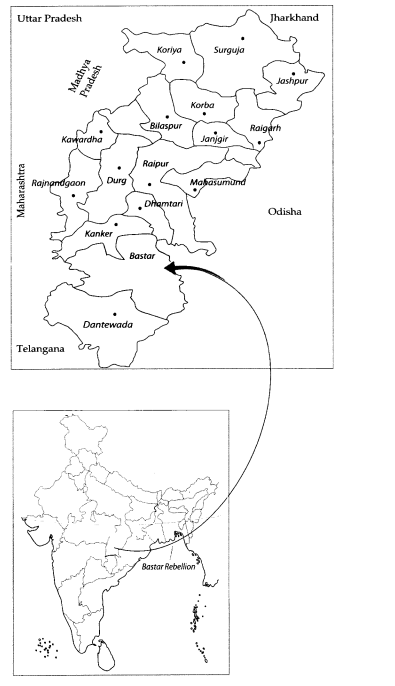
Question 1.
Local and label the following items on the given map with appropriate symbols.
1 Region of Bastar Rebellion
2 Region of Raipur
3 Region of Koriya
4 Region of Jashpur
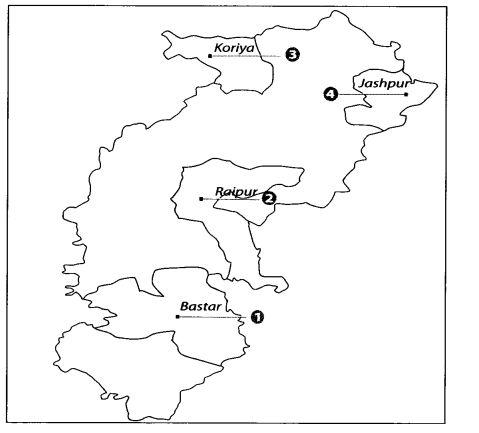
Question 2.
Locate and label the following items on the given map with appropriate symbols.
(i) Region of Bastar Rebellion
(ii) Region of Raipur
(iii) Region of Koriya
(iv) Region of Jashpur
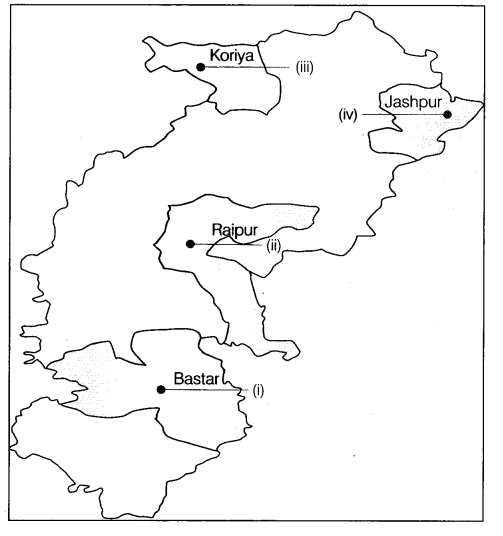
Forest Society And Colonialism Class 9th: MCQs
We have also shared some important MCQs to help the students to go through the in-depth lesson Forest Society And Colonialism Class 9th.
Question 1.
Where was the first Imperial Forest Research Institute set tip?
(a) At Dehradun
(b) At Shillong
(c) At Shimla
(d) At Uttarakhand
Answer: (a) At Dehradun
The first Imperial Forest Research Institute was set up at Dehradun.
Question 2.
Which of the following is not the name of shifting or swidden agriculture/cultivation?
(a) Milpa
(b) Chitemene or Tavy
(c) Podu/Penda
(d) Taungya
Answer: (d) Taungya
Taungya. While others are names of shifting agriculture.
Question 3.
Where is Bastar located?
(a) In Andhra Pradesh
(b) In Orissa
(c) In Southernmost parts of Chhattisgarh
(d) In Madhya Pradesh.
Answer: (c) In Southernmost parts of Chhattisgarh
Bastar is located in the southernmost parts of Chattisgarh.
Question 4.
In which country a similar situation prevailed as in the forest of Bastar?
(a) In Somalia
(b) In Indonesia
(c) In Malaysia
(d) In Sri Lanka
Answer
Answer: (b) In Indonesia
In Indonesia, a similar situation prevailed in the forest of Bastar.
Question 5.
Which of the following are the causes of the Forest Act enacted in 1865?
(a) Forests were divided into four categories.
(b) Forests were divided into three categories.
(c) Villagers could take nothing from ” these forests.
(d) Villagers could take anything from these forests.
Answer
Answer: (d) Villagers could take anything from these forests.
In the beginning, villagers took everything from the forests. This led to the enaction of Forest
Act in 1865.
Question 6.
Between 1700 to 1995, how much area of forest cover in the world was cleared for industrial use?
(a) 9.3%
(b) 8.3%
(c) 3.9%
(d) 8.5%
Answer
Answer: (a) 9.3%
About 9.3% of forest cover in the world was cleared for industrial use between 1700 is
1995.
Question 7.
Which of the following community or tribes live in Bastar?
(a) Maria
(b) Gaddis
(c) Gonds
(d) Hallas
Answer: (b) Gaddis
The Gaudin live in Bastar. White others live in different regions.
Question 8.
Who were Kalangs?
(a) Community of skilled laborers
(b) Community of skilled craftspersons
(c) Community of skilled forest cutters and shifting cultivators
(d) Skilled laborers and craftspersons who lived in central Java.
Answer: (c) Community of skilled forest cutters and shifting cultivator
Kalanga was a community of skilled forest cutters and shifting cultivators.
Question 9.
Dutch began their scientific forestry in.
(a) Sumatra
(b) Java
(c) Kalimantan
(d) West Irian
Answer
Answer: (b) Java
In Java the Dutch began their scientific forestry.
Question 10.
Sacred Groves are known as:
(i) Sarnas (ii) Devarakudu (iii) Kan (iv) Rac
(a) (i) and (iv)
(b) (iii) and (iv)
(c) only (iv) is correct
(d) All are correct.
Answer
Answer: (d) All are correct.
All four are sacred groves.
Question 11.
India’s landmass under cultivation in 1600 AD was:
(a) About 1/6th of the India’s landmass
(b) About 1/8th of the India’s landmass
(c) About 1/4th of India’s landmass
(d) About 1/3rd of India’s landmass
Answer
Answer: (a) About 1/6th of India’s landmass
In 1600 AD, India’s landmass under cultivation was about 1/6th of the land mass.
Question 12.
India forest service was set up in:
(a) 1764
(b) 1794
(c) 1864
(d) 1866
Answer
Answer: (c) 1864
In 1864 the Indian forest service was set up by the Britishers when they realised the
importance of forests.
Question 13.
When was Indian Forest Act implemented?
(a) In 1795
(b) In 1865
(c) In 1845
(d) In 1885
Answer
Answer: (b) In 1865
In 1865, the Indian Forest Act was implemented.
Question 14.
What was the total length of railway tracks in 1890?
(a) 765000 km
(b) 66500 km
(c) 25500 km
(d) 45500 km
Answer
Answer: (c) 25500 km
By 1890 the total length of railway tracks in India was 25500 km.
Question 15.
How many trees were alone cut down annually in Madras Presidency in the early 1850s to build sleepers?
(a) About 30800 trees
(b) About 35000 trees
(c) About 40000 trees
(d) About 40500 trees
Answer
Answer: (b) About 35000 trees
The British needed sleepers to build railway tracks. Thus about 35000 trees were cut down
annually in Madras Presidency in the early 1850s to build sleepers.
Question 16.
Each mile of railway track is required between and sleepers.
(a) 1760,2000
(b) 1800,2040
(c) 2000,2040
(d) 2000,2060
Answer
Answer: (a) 1760,2000
About 1760, 2000 sleepers were required for each mile of railway track.
Question 17.
Large areas of natural forests were cleared to make way for:
(a) Tea Plantation
(b) Coffee Plantation
(c) Rubber Plantation
(d) Rice, Millet, and Cotton growing
Answer
Answer: (c) Rubber Plantation
During that time rubber plantation was encouraged. Thus, large areas of natural forests
were cleared to make way for rubber plantations.
Question 18.
Who was Dietrich Brandis?
(a) The first Inspector General of Police in India.
(b) The first Inspector General of Forest in India.
(c) The first Viceroy of Forest conservation committee
(d) The first President of the Forest Survey Commission
Answer
Answer: (b) The first Inspector General of Forest in India.
To implement strict orders in forests and to introduce new measures, Dietrich Brandis was
made the first Inspector General of Forest in India.
Question 19.
When was Forest Act amended after its implementation in 1865?
(a) In 1878 and in 1927
(b) In 1876 and in 1907
(c) In 1878 and in 1907
(d) In 1876 and in 1917.
Answer
Answer: (a) In 1878 and in 1927
The Forest Act was implemented in 1865. However, it was amended twice in 1878 and in
1927.
Question 20.
According to Forest Act 1878, forests were divided into three categories, these are:
(a) Reserved, Protected, and Community forest.
(b) Open, Registered, and Village Forest.
(c) Natural forests, Reserved and Protected forests.
(d) Reserved, Protected, and Village forests.
Answer
Answer: (d) Reserved, Protected, and Village forests.
According to the Forest Act of 1878, forests were divided into three categories, namely
reserved, protected, and village forests.
Conclusion
We have shared some Forest Society and Colonialism Class 9th important maps regarding Forest Society And Colonialism Class 9th to help the students with the chapter along with NCERT Solutions For Class 9th Forest Society And Colonialism. We have shared notes along with some important diagrams and map work to help the students.
Related Articles
- Consumer Rights Class 10th Social Science
- Drainage Class 9th NCERT Solutions Geography
- Gender, Religion, And Caste Class 10th Social Science
- Political Parties Class 10th Social Science
- Socialism In Europe And The Russian Revolution Class 9 Social Science
- Electoral Politics Class 9th Social Science
- Globalization And The Indian Economy Class 10th Economics
- Constitutional Design: Class 9 Social Science

